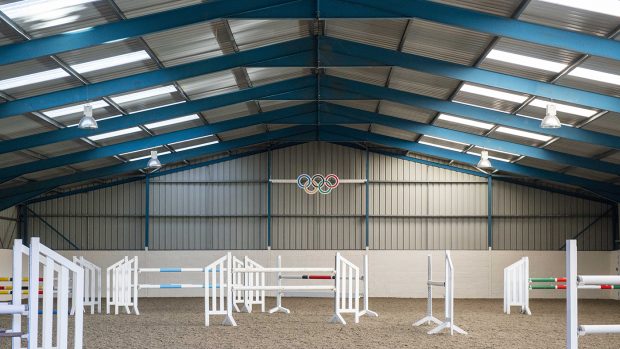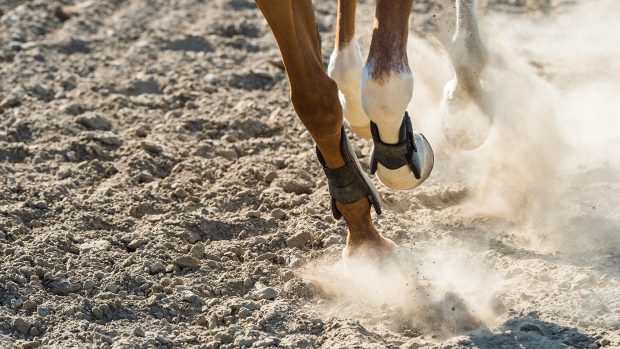So you’ve decided to build your own arena. To avoid the common pitfalls, we have spoken to the expects to find out how to build a riding arena and what are the key points you need to consider before taking the plunge.
1. Location
If building a riding arena will be part of a bigger equestrian project, consider the whole layout upfront.
“You don’t want to compromise on the best solution,” advises Charles Britton, who runs the 40-year-old equestrian facilities company of the same name.
“Authorities are typically not keen for facilities to sprawl over too large an area, so putting it nearer to existing facilities will always make it easier to secure support,” he says.
While hedgerows and trees can provide shelter from prevailing wind, most installers advise steering clear because of the problems created by falling leaves and roots — while planners also object to the impact on mature trees.
Soil conditions can also be a consideration.
“An arena can be built on almost any ground, but if there are difficult conditions — for example if it’s rocky or boggy — then it is going to need more investment in either equipment or materials, so if there is an alternative position, consider it,” advises Charles. “Similarly, if you can’t get at least eight-wheel tipper lorries to the site, costs will be greater for smaller lorries or re-handling of materials.”
“Don’t worry too much about earthworks,” notes Total Equestrian Construction’s Steve Keen. “People are concerned if they have a slope that it will be expensive, but usually it’s the cheapest part.”
2. Size
The most popular arena size is 40x20m, while those dedicated to dressage may opt for a 60x20m layout. For jumping arenas, extra width is recommended.
“Even 40x25m makes a difference to where you can site jumps, so I always advise people to go for the extra five metres if they can,” says Steve.
Charles Britton also suggests being clear on how the arena will be used.
“Some uses are better served by another, separate facility. If you do a lot of lungeing, the arena can potentially be harmed by intense, concentrated activity. You may be better off having a separate lungeing arena, perhaps making the main arena a bit smaller to fund it.”
Continued below…

An arena with a view: check out Badminton winner Piggy March’s fabulous yard
Take a virtual tour round event rider Piggy March’s beautiful Northamptonshire base

Subscribe to Horse & Hound this spring for great savings
3. Base and drainage
The base is unquestionably the most important aspect of an arena build. If it isn’t constructed properly, the arena surface will never perform as intended and pooling water and soft spots will result.
“When you build an arena, only the surface and the fencing should need changing when they reach the end of their life expectancy, nothing else,” says Jackson Arena’s James Alford.
Different installers have different approaches to the structure of drainage — and it is an area for the expert to advise — but don’t skimp on stone or membranes.
“The key issue is hard limestone for the drainage network. It’s clean and it keeps the drains clean,” says James.
Leisure Ride’s chief executive officer Ross Hemming agrees: “You want the stone to be as hard as possible — limestone or granite work best, and it needs to be evenly compacted.” Having a suitable top membrane is also important to prevent puncturing.
“We recommend a minimum of 300g per square metre Newton tear strength,” Ross adds.
4. Surfaces
With such a wide range on offer — and many differing opinions as to what works best — choosing a surface can be a minefield.
Should you opt for woodchip, PVC, rubber-mix or sand and fibre?
“It is the one question that everyone gets hooked up on, yet it’s just a part of the whole decision process,” says Charles. “We would always stress though, don’t compromise on the rest of the structure to install a top-price surface — it won’t work.”
For most people, the primary factors influencing surface choice are budget and the level and type of use.
If you want to get a feel for the type of ride you are looking for and what would best suit the requirements of your discipline, try to see a surface in work rather than just viewing samples.
Most people installing an outdoor arena opt for a sand-based surface, and Ross has some basic advice: “The sand is most important thing. The surface will always ride deep if it’s wrong. You need angular, high-quality silica sand, not round grains. Damp binds the angular grains together.”
“Good” going on natural turf is considered the best surface for a horse, and this is what additives to sand are trying to mimic.
“Fibres of the right consistency will emulate turf’s root structure,” Ross explains.
Sand and rubber is a popular budget surface, whereas at the other end of the spectrum there is wax.
Wax surfaces were pioneered by Martin Collins Enterprises more than 30 years ago and are designed to provide the most consistent ride — although with greater capital outlay.
“Wax makes a surface behave as though it’s wet and minimises dust. It also repels water, which makes the arena less likely to freeze,” says Martin’s son Nicholas.
“It gives you finer control to create the ride you want — a surface should have controlled movement, balancing hoof stability and support with ‘give’.”
It is wise to remember that the “perfect” surface arguably does not exist and that maintenance will always be key.
“Everybody wants a surface that you don’t have to maintain, that doesn’t freeze in winter or need watering in summer,” adds Ross. “You can’t have a very low maintenance surface without giving up something else — usually performance.”
5. Planning permission
Most arena installation companies offer a “turn key” solution that includes handling the process for you. However, if you are going it alone, it’s useful to be aware of the issues that are most likely to concern your county council. The planning permission process can take up to three months.
“For equestrian builds, it’s worth contacting your local planning authority before doing anything else. They can tell you what is more likely to be acceptable,” says Gill Davies from Martin Collins.
One of the most common areas of compromise is lighting, which can pose aesthetic considerations as well as troubling neighbours.
“When siting an arena, it’s worth considering if there is traffic passing on a nearby highway that might prevent you installing lighting,” says Charles.
Modern LED lights mounted on the fencing rather than a pole can provide a work-around.
The location of drains is also important.
“Some councils want to know where the outfall is — it may be going into a ditch adjacent to a road or impacting a neighbour’s land,” says Ross.
When building in an area of outstanding natural beauty (AONB), aesthetic considerations can be of high importance.
“We currently have a build in Malvern where the client wanted light coloured sand but the council wanted the surface toned down,” says Ross.
“They didn’t want bright white in the middle of a green field. We managed to source sand from a different region — it was still silica sand but darker.”
6. Finishing touches
Fences
If you are installing the fencing yourself, do the job properly to ensure longevity.
“We always concrete the fencing in because if you don’t, within a couple of years it will bow out and look horrible,” explains Ross. “We also re-treat the bottom of our fence posts with bitumin before putting them in the ground.”
Ross also advises not skimping on kickboards.
“We have stone that comes under the kickboard as they are more likely to rot in contact with soil. You need a height of 13-15in of timber to prevent surface loss,” he adds.
Charles Britton cautions against pitting budget against safety.
“Fence height is important — a flimsy fence that is too low can actually be a danger. We
recommend 4ft 6in above the top of the riding surface, which is about 5ft 6in out of the ground,” he says.
Gates
If you want to practise dressage test riding, a central entrance on a kickboard arena might be the option for you. Otherwise, Ross advises that gates are best located offset or in the middle of a long side.
“We will never put a gate on the centre line. If a gate is left open, a naughty horse on the centre line will be out of the gate and gone. We also try not to put them in a corner for the same reason,” he says.
Mirrors
Universal advice for installing mirrors is that in order to avoid glare, you should check the direction of the sun at the time of day when you are most likely to be riding.
They should be angled towards the ground and attached to a framework rather than directly to fencing.
7. The cost
Unsurprisingly a number of factors will impact the cost, but as an example, Jackson Arenas quotes £19,500 plus VAT for a “budget” arena.
Most arena installation companies strongly caution against cutting corners, as many lower-cost fixes will only shorten the lifespan of the arena or take additional expense to remedy later on.
For those on a tight budget, there are some areas where you might make savings.
“Cut your size, not your budget,” suggests Charles.
“If you want a big arena but can’t afford it yet, and it is a site requiring cut and fill, have it levelled ready for a big arena and extend later.”
James Alford believes some savings can be made on the finishing details.
“The only place where you can really save money is fencing,” he says. “Sometimes it’s an option to use round machine posts, which are quicker to put in. A fence isn’t essential — you could just have kickboards.”
While it is better to install your chosen arena surface from the beginning — as taking up and replacing a surface results in added costs later on — if you are building on a budget, having a long-term plan to upgrade is a possibility.
“It might be worth putting up with a surface that isn’t your first choice for a couple of years,” advises Ross. “If you buy good quality angular silica sand to begin with, surfaces can be improved with the right fibre.”
For all the latest equestrian news and reports, don’t miss Horse & Hound magazine, out every Thursday, and in the latest issue, don’t miss our arenas special, out now (dated 6 June 2019)





